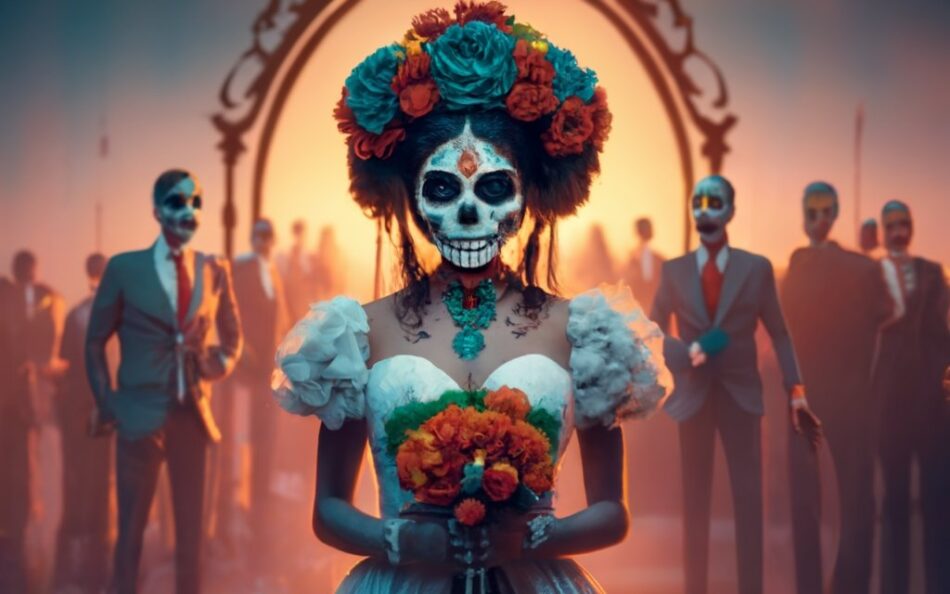Every autumn, here in Spain, families gather to honour their loved ones on Día de Los Muertos. Despite its name, which means Day of the Dead, it’s a joyful celebration. This tradition aligns with two other Catholic holy days, All Saints’ Day on November 1 and All Souls’ Day on November 2.
The Day of the Dead is a unique and ancient celebration filled with tasty foods, sugar skulls, and vibrant flowers. In Spain, Latin communities celebrate it with gothic yet lively displays of skulls and fauna. But what’s the meaning behind it?
Let’s delve into the significance of Dia de Los Muertos Decor.
How Dia De Los Muertos is Celebrated
It’s crucial to understand that the Day of the Dead is distinct from Halloween, rooted in pagan traditions from Celtic Europe over 2,000 years ago. With its increasing presence in pop culture, Day of the Dead is now more popular than ever.

Spanish Halloween: a Three-Day Celebration?
Halloween in Spain, with its unique traditions, differs slightly from the Western version. There’s Da de las Brujas (Day of Witches) on October 31, Da de Todos Los Santos (All Saints Day) on November 1, and Da de Los Muertos/Difuntos (Day of the Dead/All Souls Day) on November 2. The Spanish equivalent of Halloween, ‘Da de las Brujas,’ isn’t a major celebration day.
On the 31st, celebrations are mainly in larger cities, where Halloween has become a commercialized holiday. However, November 1 is Spain’s most crucial celebration day, All Saints Day. It’s a day to honour saints and loved ones by visiting hometowns and placing flowers on their graves.
Unlike typical Halloween parties with ghosts and ghouls, these community celebrations are traditional and religious.
La Castañada
On October 31 in northern Spain, regions like Galicia, Asturias, and Cantabria celebrate La Castañada. Families roast chestnuts and sweet potatoes in Catalonia to welcome All Saints’ Day morning. This tradition dates back centuries when bell-ringers rang bells all night and were given food like chestnuts to keep them going. Traditional celebratory foods included almond sweets with various flavours served with sweet wine, known as ‘panellets.’
Dia de Los Muertos Altar
The Day of the Dead celebrations are incomplete without an altar, known as Ofrenda. Traditionally, an Ofrenda is where you place photos and items that remind you of your deceased loved ones; these include their favourite foods, drinks, perfumes, flowers, and anything else that brings back memories.
The candlelight, sweet-smelling flowers, and good food on the altar guide your family members back for a brief visit on Da de Los Muertos (November 1 and 2). These altars are highly customizable but must represent the four elements: fire (candles), wind (papel picado), earth (food), and water (water).

Dia de Los Muertos Flowers
Various flowers hold symbolic meanings on the Day of the Dead:
– Marigolds: Help the dead find their way home with their vibrant hues and fragrances.
– Cockscomb: Symbolizes Christ’s blood and resurrection, often combined with marigolds for a vibrant display.
– Gladioli: Symbolize remembrance and faithfulness in various colours.
– White Hoary Stock: Represents the memory of lost children.
– Baby’s Breath: Symbolizes purity, innocence, and love.
– Chrysanthemums: Represent beauty, peace, and sympathy, often used in flower crowns and altars.
In Spain, All Saints Day aligns with Dia de Los Muertos, a time to honour saints and adorn loved ones’ graves with flowers.
So, whether you follow the spooky traditions of Halloween or Day of The Dead, we could still say people will be in good spirits (lol, sorry couldn’t resist!)
Until Next Time
Related
